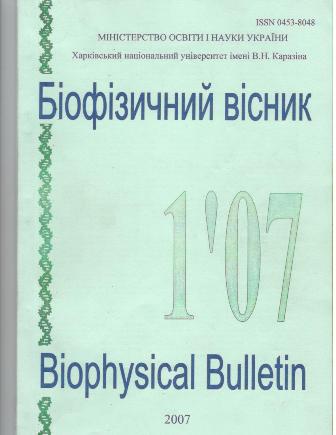Electrical properties of the protein molecule in two - terminal device
Abstract
Here we present a mathematical model of the single protein molecule in two-terminal device as complex irregular impedance network. It is applied for the prediction of the response of the electronic nanobiosensor based on the single molecule of G-protein coupled receptor (GPCR) family protein. The protein molecule is modeled as a complex network of elementary impedances where nodes correspond to alpha-carbon atoms of the protein aminoacids residues, and links correspond to some electrical interaction between them. Links connect each pair of aminoacids close enough in space and each link corresponds to an elementary impedance. The impedance value depends on the kin of the corresponding pair of aminoacids and distance between them. Correspondingly, conformational changes of the GPCR molecule transmit to the variation of its electrical properties. The change of rhodopsin molecule impedance with photon capture is calculated. The results for the different values of model parameters are presented and discusse.
Downloads
References
Alon U. Biological networks: the tinkerer as an engineer. Science. 2003;301:1866-7.
Tzong-Zeng Wu. A piezoelectric biosensor as an olfactory receptor for odour detection: electronic nosc. Biosensors and Bioelectronics. 1999;14:9-18.
Joachim C, Gimzewski JK, Aviram A. Electronics using hybrid-molecular and mono-molecular devices. Nature. 2000;408:541-8.
Bayley H, Cremer PS. Stochastic sensors inspired by biology. Nature. 2001;413:226-30.
Firestein S. How the olfactory system makes sense of scents. Nature. 2001;413:211-8.
Xie Q, Archontis G, Skourtis SS. Protein electron transfer: a numerical study of tunneling through uctuationg bridges. Chem. Phys. Lett. 1999;12:237-46.
Bezrukov SM, Winterhalter W. Examining noise sources at the single-molecule level: l/f noise of an open maltoporin channel. Phys. Rev. Lett. 2000;85:202-5.
Lameh J, Cone RI, Maeda S, Philip M, Corbani M, N’adasdi L, et al. Structure and function of G protein coupled receptors. Pharmaceutical Research. 1990;7:1213-21.
Shacham S, Topf M, Avisar N, Glaser F, Marantz Y, Bar-Haim S, et al. Modeling the 3D structure of GPCRs from sequence. Medical RFesearch Reviews. 2001;21:472-83.
Vaidehi N, Floriano WB, Trabanino R, Hall SE, Freddolino P, Choi EJ, et al. Prediction of structure and function of G protein coupled receptors. PNAS. 2002;99:12622-7.
Chou KC, Elrod DW. Bioinformatical analysis of G-protein-coupled receptors. Journal of Proteome Research. 2002;1:429-33.
Gether U, Kobilka BK. G protein-coupled receptors. Journ. Bio. Chem. 1998;273:17979-82.
Palezewski K, Hori T, Behnke CA, Motoshima H, Fox BA, Le Trong I, et al. Crystal structure of Rhodopsin: A G protein- coupled receptor. Science. 2000;289:739-45.
Yaegle PL, Choi G, Albert AD. Studies on the structure of g-protein-coupled receptor rhodopsin including the putative g-protein binding site in unactivated and activated forms. Biochemistry. 2001;40:11932-7.
Choi G, Landin J, Galan JF, Birge RR, Albert AD, Yeagle PL. Structural studies on metharhodopsin II, the activated form of the g-protein coupled receptor rhodopsin. Biochemistry. 2002;41:7318-24.
Sakmar TP, Menon ST, Marin EP, Awad ES. RHODOPSIN: Insights from recent structural studies. Annu. Biomol. Struct. 2002;31:443-82.
Pilpel Y, Lancet D. The variable and conserved interfaces of modeled olfactoty receptor protein. Protein Science. 1999;8:969-77.
Crasto C, Singer MS, Shepherd GM. The olfactory receptor family album. Genome Biology. 2001;2:1027.1-4.
Liu AH, Zhang X, Stolovitzky GA, Califano A, Firestein SJ. Electronics using hybrid-molecular and monomolecular devices. Nature. 2000;408:541-8.
Research Collaboratory for Structural Bioinformatics, Protein data bank, publisher State University of New Jersey. Address http://www.rcsb.org/pdb
Yand H, Luo G, Karnchanaphanurach P, Louie TM, Rech I, Cova S, et al. Protein conformational dynamics probed by single-molecule electron transfer. Sciences. 2003;302:262-6.
Kobilka B, Gether U, Seifert M, Lin S, Ghanouni P. Examination of ligand-induced conformational changes in the beta 2 andrenergic receptor. Life Sciences. 1998;62:1509-12.
Kobilka B, Gether U, Seifert M, Lin S, Ghanouni P. Characterization of ligand-induced conformational states in the beta 2 andrenergic receptor. J. Receptor and Signal Transduction Research. 199;19:293-300.
Xueyu Song. An inhomogeneous model of protein dielectric properties: intrinsic polarizabilities of amino acids. J. Chem. Phys. 2002;116:9359-83.
Rammal R, Tannous C, Tremblay AMS. l/f noise in random resistor networks: fractals and percolating systems. Phys. Rev. A. 1985;31:2662-71.
Jeong H, Tombor B, Albert R, Oltvai ZN, Barabasi AL. The large-scale organization of metabolic networks. Nature. 2000;407:651-4.
Albert R, Barabasi AL. Statistical mechanics of complex networks. Rev. Mod. Phys. 2002;74:47-97.
Authors who publish with this journal agree to the following terms:
- Authors retain copyright and grant the journal right of first publication with the work simultaneously licensed under a Creative Commons Attribution License that allows others to share the work with an acknowledgement of the work's authorship and initial publication in this journal.
- Authors are able to enter into separate, additional contractual arrangements for the non-exclusive distribution of the journal's published version of the work (e.g., post it to an institutional repository or publish it in a book), with an acknowledgement of its initial publication in this journal.
- Authors are permitted and encouraged to post their work online (e.g., in institutional repositories or on their website) prior to and during the submission process, as it can lead to productive exchanges, as well as earlier and greater citation of published work (See The Effect of Open Access).




